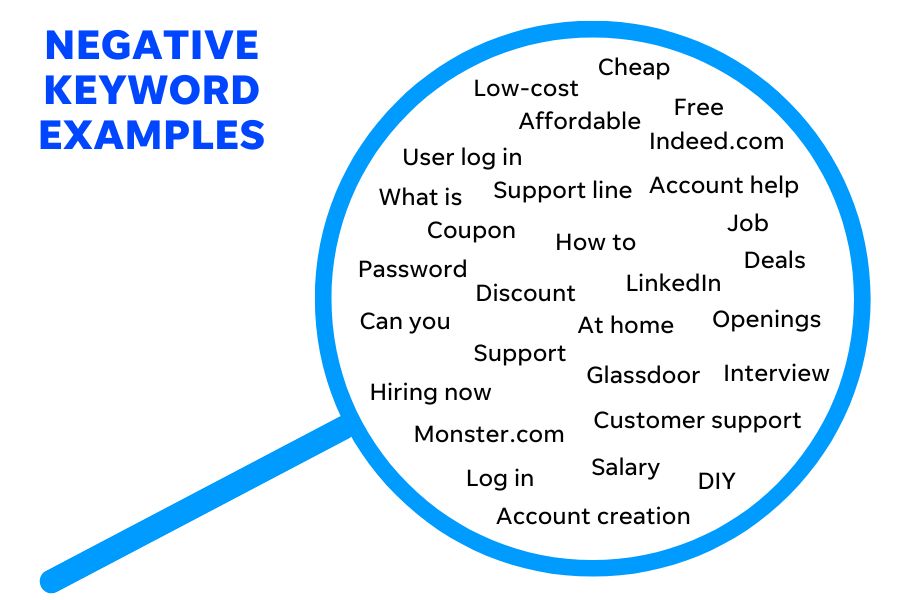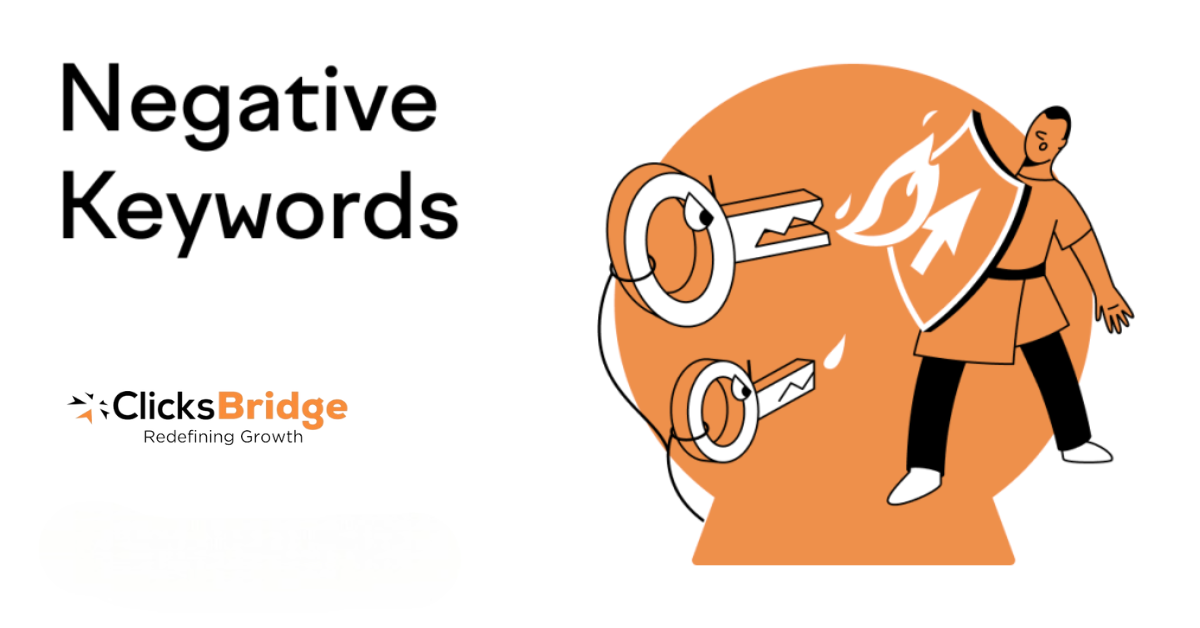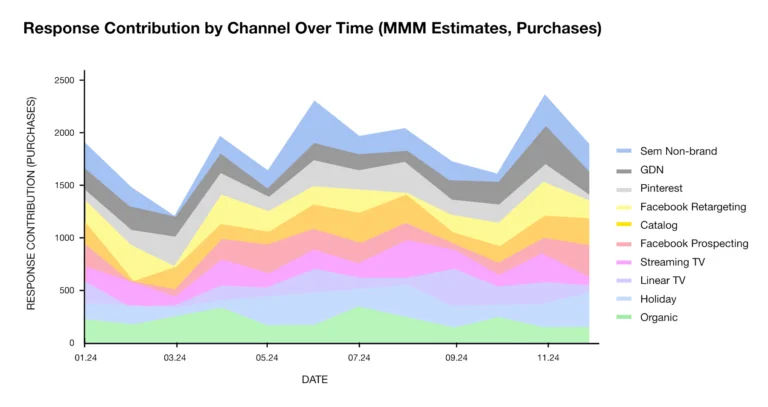Mastering negative keywords is essential for optimizing Google Ads campaigns. A WordStream study found that businesses waste up to 76% of their ad budget on irrelevant clicks. Effectively using negative keywords can significantly reduce wasted spend, enhance ad relevance, and increase conversion rates.
Understanding how to identify and apply negative keywords correctly helps advertisers achieve better targeting and higher ROI. This guide explores strategies, match types, and best practices to refine paid search campaigns for maximum efficiency.
Why Negative Keywords Are Your Secret Weapon?
Negative keywords are one of the most overlooked yet powerful tools in Google Ads. Many advertisers focus on bidding strategies and ad copy, but without a strong negative keyword strategy, a significant portion of ad spend is wasted. A 2023 WordStream report found that 20-30% of PPC budgets are lost to irrelevant clicks, saving money that could be better allocated to high-intent traffic.
This is where negative keywords make all the difference. By preventing ads from appearing for unrelated searches, they improve ad relevance, reduce wasted spend, and drive higher conversions. Mastering negative keywords isn’t just about saving money, it’s about refining your audience and maximizing ROI.
What Are Negative Keywords and How to Use Them Effectively
Negative keywords are terms or phrases that prevent your ads from appearing when searched. If a user types in a query containing a negative keyword, your ad won’t be shown. This simple adjustment can have a major impact on ad performance by ensuring your budget is spent on users actively looking for what you offer.
For example, a luxury watch retailer might exclude terms like “cheap” or “used” to avoid attracting bargain hunters who aren’t their target audience.
Why do negative keywords matter? They help eliminate wasted ad spend, improve ad relevance, and protect your brand from irrelevant traffic. Without them, your ads could appear for unrelated searches, leading to high costs with little to no return.
A well-structured negative keyword list keeps campaigns focused, cost-efficient, and conversion-driven. Let’s explore how to implement them effectively.

Types of Negative Keywords in Google Ads
Negative keywords in paid search work differently than positive keywords. Match types matter here.
Broad match blocks terms in any order. Phrase match targets exact phrases. The exact match is super specific. Choose wisely based on your goals. This is the foundation of mastering negative keywords, precision meets efficiency.
| Negative Match Type | Description | Example |
|---|---|---|
| Broad Match | Ads won’t show if all terms appear in the query in any order. | Keyword: cheap shoes Blocked queries: buy cheap shoes, cheap sneakers, shoes cheap |
| Phrase Match | Ads won’t show if the exact phrase appears in the same order. | Keyword: running shoes Blocked queries: best running shoes, men’s running shoes |
| Exact Match | Ads won’t show if the exact term appears without extra words. | Keyword: Nike shoes Blocked queries: Nike shoes but not Nike running shoes |
The RIGHT WAY To Find & Add Negative Keywords
Finding negative keywords isn’t guesswork; it’s strategy. Start with your Search Terms Report. Look for queries with high clicks but zero conversions. These are budget drains.
For instance, a furniture store might see “free furniture” popping up. Add it as a phrase that matches the negative keyword to stop the bleeding.
Next, think proactively. List terms unrelated to your offer such as competitors’ names or off-brand intent signals (e.g., “DIY” for a service-based business). Tools like Google Keyword Planner can spark ideas too. Add them at the campaign or ad group level for control. This is the right way to find & add negative keywords.
Negative Keywords and Ad Targeting
Ad targeting thrives on relevance. Negative keywords refine who sees your ads. Give it a thought for as second. You sell premium coffee machines. Without negatives, your ad might hit “instant coffee” searches and get wasted spend. By mastering negative keywords and ad targeting, you focus on high-intent buyers only.
You can compare platforms too. Google’s broad matching is forgiving, but Bing’s is aggressive. Adjust your negative keywords list accordingly. Layer negatives at campaign and ad group levels for precision. It’s about hitting the bullseye every time.

6 Strategies for Effective Implementation
Let’s get tactical. Here are six proven strategies to nail negative keywords in paid search:
- Spot Irrelevant Terms Early
Exclude generic or off-topic words up front. Selling software? Block “hardware” or “free trial” if it doesn’t fit. - Set Performance Thresholds
Define rules: if a term costs $50 with no conversions, it’s a negative. Adjust timelines for aggressive or relaxed approaches. - Analyze Secondary Metrics
Low CTR or high CPC queries might not need blocking, just tweak match types. It’s a negative keyword in digital marketing finesse move. - Mine Search Term Reports
Regularly check what triggers your ads. Add misaligned queries as Google Ads negative keywords list entries. - Block Brand-Damaging Terms
Selling toys? Exclude “broken” or “unsafe.” Protect your reputation from the start. - Filter Misaligned Intent
Terms like “what” or “why” often signal info-seekers, not buyers. Add them to refine traffic.

Best Practices to Optimize Google Ads
Optimization is an art. Follow these best practices to optimize Google Ads with negative keywords:
- Start Broad, Then Narrow: Begin with obvious exclusions, then refine with data.
- Leverage Automation: Use rules to flag high-cost, low-value terms. Try scripts.
- Test and Tweak: Add negatives, then watch keyword-level performance.
- Cross-Campaign Sync: Use shared lists to avoid overlap in multi-campaign setups.
Think of it like green gardening, prune the weeds (how to find negative keywords) to let the flowers bloom.
Why Invest in Negative Keywords?
Still skeptical? Here’s why negative keywords deserve your attention:
Cost Savings: A 2023 HubSpot report showed that 25% of PPC budgets are wasted without negatives.
Higher ROI: Relevant clicks mean better conversions, up to 20% more, per SEMrush data.
Brand Protection: Avoid bad associations. A clean negative keywords list keeps your image intact.
Efficiency: Focus spend on high-intent searches, not tire-kickers.
With vs. Without Negative Keywords Comparison
| Metric | With Negative Keywords | Without Negative Keywords |
|---|---|---|
| Cost Per Click (CPC) | $1.50 | $3.00 |
| Click-Through Rate | 5% | 2% |
| Conversion Rate | 10% | 4% |
| Wasted Spend | 10% | 30% |
FAQs on Negative Keywords
- What are negative keywords in Google Ads broad match?
Broad match negatives block ads if all terms appear in any order. It’s wide-reaching but can miss close variants. - What is the difference between negative targeting and negative keywords?
Negative targeting excludes audiences or placements. Negative keywords block specific search terms. Both refine reach differently. - What are negative keywords, and how do they impact the success of SEM campaigns?
They’re terms you exclude to avoid irrelevant clicks. In SEM, they lift ROI by focusing spending on intent-driven searches. - How many negative keywords can you use in Google Ads?
Google limits you to 10,000 per campaign. Use negative keyword lists wisely to maximize coverage. - What are negative keywords, and why are they important in a PPC campaign?
They stop ads from showing for off-target queries. Their importance in Google Ads campaigns lies in cost control and relevance.
Final Thoughts
A well-planned negative keyword strategy can make the difference between wasted ad spend and high-quality traffic. Whether you’re running local campaigns that need to exclude out-of-market locations or e-commerce ads that should filter out bargain hunters and DIY searches, refining your negative keyword list is essential.
To get the most out of negative keywords
- Regularly review search term reports to find irrelevant queries.
- Continuously update your list as your campaigns evolve.
- Start small and build over time, being too restrictive too soon can limit growth.
- Remember that user intent isn’t always in a single keyword but in the full journey leading up to conversion.
Negative keywords aren’t just about blocking irrelevant searches, they help focus your budget on the right audience, improving ad relevance, and maximizing ROI.
Need help refining your negative keyword strategy?
Our experts at clicksbridge media can help you eliminate wasted ad spend, improve targeting, and maximize your ROI. Get in touch today for a free campaign audit and start optimizing your Google Ads performance.



